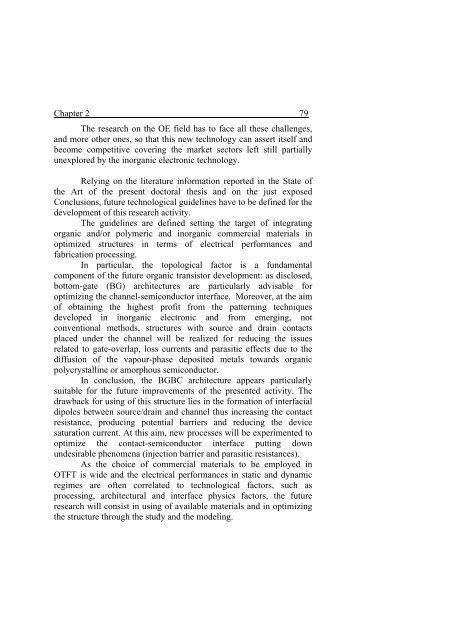tesi R. Miscioscia.pdf - EleA@UniSA
tesi R. Miscioscia.pdf - EleA@UniSA
tesi R. Miscioscia.pdf - EleA@UniSA
Create successful ePaper yourself
Turn your PDF publications into a flip-book with our unique Google optimized e-Paper software.
Chapter 2 79<br />
The research on the OE field has to face all these challenges,<br />
and more other ones, so that this new technology can assert itself and<br />
become competitive covering the market sectors left still partially<br />
unexplored by the inorganic electronic technology.<br />
Relying on the literature information reported in the State of<br />
the Art of the present doctoral thesis and on the just exposed<br />
Conclusions, future technological guidelines have to be defined for the<br />
development of this research activity.<br />
The guidelines are defined setting the target of integrating<br />
organic and/or polymeric and inorganic commercial materials in<br />
optimized structures in terms of electrical performances and<br />
fabrication processing.<br />
In particular, the topological factor is a fundamental<br />
component of the future organic transistor development: as disclosed,<br />
bottom-gate (BG) architectures are particularly advisable for<br />
optimizing the channel-semiconductor interface. Moreover, at the aim<br />
of obtaining the highest profit from the patterning techniques<br />
developed in inorganic electronic and from emerging, not<br />
conventional methods, structures with source and drain contacts<br />
placed under the channel will be realized for reducing the issues<br />
related to gate-overlap, loss currents and parasitic effects due to the<br />
diffusion of the vapour-phase deposited metals towards organic<br />
polycrystalline or amorphous semiconductor.<br />
In conclusion, the BGBC architecture appears particularly<br />
suitable for the future improvements of the presented activity. The<br />
drawback for using of this structure lies in the formation of interfacial<br />
dipoles between source/drain and channel thus increasing the contact<br />
resistance, producing potential barriers and reducing the device<br />
saturation current. At this aim, new processes will be experimented to<br />
optimize the contact-semiconductor interface putting down<br />
undesirable phenomena (injection barrier and parasitic resistances).<br />
As the choice of commercial materials to be employed in<br />
OTFT is wide and the electrical performances in static and dynamic<br />
regimes are often correlated to technological factors, such as<br />
processing, architectural and interface physics factors, the future<br />
research will consist in using of available materials and in optimizing<br />
the structure through the study and the modeling.
















